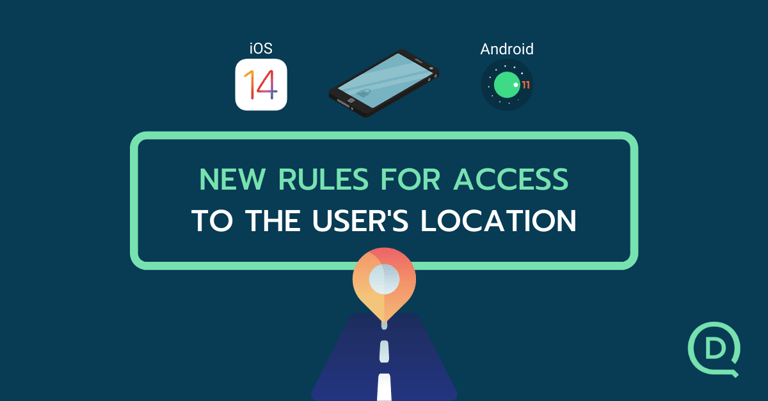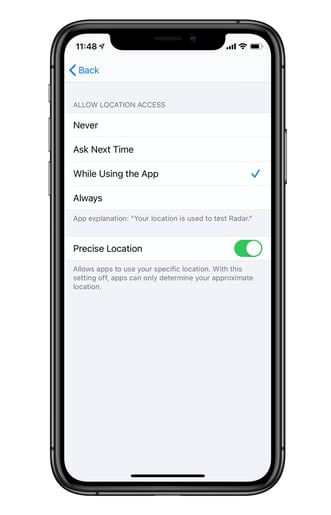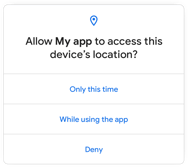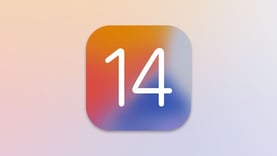September is the time for Google and Apple to deploy new versions of their operating systems. In particular, the American firms have introduced additional mechanisms in Android 11 and iOS 14 to protect the privacy of their users and their location data. We tell you all about these new features and how we anticipated these changes.

What's new in the latest iOS and Android updates?
Many features were added to iOS and Android to enhance the user experience. In this article we will only focus on the changes that concern user location data, as they have a direct influence on the operation of mobile telematics applications. Secondly, we will present the changes that have been made to DriveQuant products to ensure an optimal experience when using them. In addition, you can find the complete list of updates for iOS 14 on the Apple website and for Android 11 on the Google website.
iOS 14 introduces the concept of approximate location
 Just over a year ago, Apple released iOS 13 with a new request prompt that allowed a user to grant location permission once or while using the app, but not permanently. At DriveQuant, we anticipated this change by simplifying access to the 'Always allow' setting in our white-labelled mobile applications and via the 'Permissions Utils' module of the DriveKit SDK. This autumn, Apple is going even further in this direction by integrating the notion of approximate location in iOS 14 to protect user privacy.
Just over a year ago, Apple released iOS 13 with a new request prompt that allowed a user to grant location permission once or while using the app, but not permanently. At DriveQuant, we anticipated this change by simplifying access to the 'Always allow' setting in our white-labelled mobile applications and via the 'Permissions Utils' module of the DriveKit SDK. This autumn, Apple is going even further in this direction by integrating the notion of approximate location in iOS 14 to protect user privacy.
So far, when an application's location permission request was approved, it allowed the app to access the exact position of the user. With iOS 14, the application will have to deal with an approximate location, updated approximately every four hours within a randomly defined radius. While this mechanism protects the user against the abuse of certain applications, it is not compatible with the normal use of a mobile telematics application. Such an app legitimately needs consent to share the exact geographical position of the user in order to be able to provide its driving analysis services. In this article, we will see how the DriveKit SDK and our mobile applications now handle this new setting.
What are the key dates for the deployment of iOS 14?
Apple officially launched iOS 14 on 16 September 2020. The new update is therefore already available on all iPhones compatible with iOS 13.
Android 11 also integrates a one-time permission system
 In a similar vein to what Apple had proposed with iOS 13, Google in turn integrates the notion of one-time permissions granted to applications to access location in its Android 11 OS. Users can thus choose to share their location with a third-party application "Only once" when they open it. Once the app is closed, the permission then ends and it is no longer allowed to access and use user location.
In a similar vein to what Apple had proposed with iOS 13, Google in turn integrates the notion of one-time permissions granted to applications to access location in its Android 11 OS. Users can thus choose to share their location with a third-party application "Only once" when they open it. Once the app is closed, the permission then ends and it is no longer allowed to access and use user location.
Google has also announced that the Play Store will allow applications to request access to your location only if this is necessary to "perform their primary function". This will obviously be the case for telematics apps. As a reminder, restrictive permissions already existed since the release of Android 10, allowing access to the device's location only when the application was active in the foreground. They have now been extended to functions other than geolocation.
What are the dates to remember for the roll-out of Android 11?
Google started deploying the Android 11 update on 8 September 2020. It initially concerns smartphones with a native version of Android such as Google Pixel. It will progressively be rolled out by all Android phone manufacturers.
These updates were already anticipated at DriveQuant
User privacy as a priority
If there is one subject on which we are in phase with these two American giants, it is the protection of users' privacy and personal data. DriveQuant's activity is built upon the collection and analysis of mobility data from users of mobile telematics applications. The notions of informed consent and transparent use of personal data are part of our DNA. We ensure that each and every piece of data collected is justified by the delivery of a specific service to the end user. Thus, we share their approach because too many abuses are committed in this matter.
DriveKit and our white label apps are evolving to meet these new rules
These updates had been in the pipes of the two American firms for several months. DriveQuant's technical teams were therefore able to anticipate them and test the beta versions of these OSs to provide an optimal experience for all users of our white label apps or applications that embed the DriveKit SDK.
Resources for iOS 14
 Check out our new iOS location permission flow tutorial to guide the user of you mobile telematics app:
Check out our new iOS location permission flow tutorial to guide the user of you mobile telematics app:
- to “Always allow” location access even when the app is running in the background,
- to enable “Exact position” (default value) and avoid access to an approximate location.
Read our technical documentation for more details about DriveKit’s module update ‘Permissions Utils’.
Resources for Android 11
 Check out our 2-steps location permission flow tutorial for the user of your mobile telematics app to “Allow all the time” access to location even when the app is running in the background.
Check out our 2-steps location permission flow tutorial for the user of your mobile telematics app to “Allow all the time” access to location even when the app is running in the background.
Read our technical documentation for more details about DriveKit’s module update ‘Permissions Utils’.

